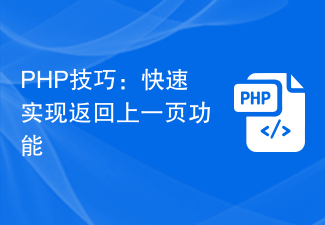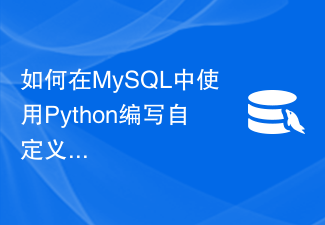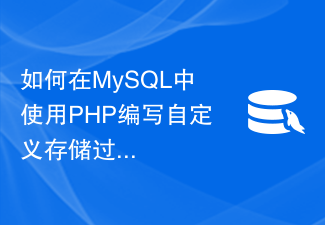Custom functions in PHP can return values of specified types through the return statement, including strings, numbers, arrays, and objects. Practical case: - Return string: function greet($name) { return "Hello, $name!"; } - Return array: function get_user_data($id) { return ["name" => "John", "email " => "john@example.com"]; }

How to return the value of a custom function in PHP?
In PHP, custom functions can return values of specified types. You can use the return statement to return a value, and the return value can be of various types, including strings, numbers, arrays, and objects.
Syntax:
function function_name(...$parameters): return_type
{
// 函数体
return $value;
}Where:
- ##function_name
is the name of the function. - ...$parameters
is an optional parameter list. - return_type
is the type of value returned by the function. - return $value;
is thereturnstatement, used to specify the function return value.
Practical case:
The following is an example of a custom function that returns a string:function greet($name)
{
return "Hello, $name!";
}
$greeting = greet("John");
echo $greeting; // 输出: Hello, John!The following is a custom function that returns an array Example of defining a function: function get_user_data($id)
{
$data = [
"name" => "John",
"email" => "john@example.com",
];
return $data;
}
$user_data = get_user_data(1);
echo $user_data["name"]; // 输出: John
Tip:
- Make sure the function return type matches the expected return value type.
- If a function does not explicitly specify a return type, it will return a
- null
value.You can use the - void
keyword to specify that a function will not return any value.
The above is the detailed content of How to return the value of a PHP custom function?. For more information, please follow other related articles on the PHP Chinese website!
 PHP技巧:快速实现返回上一页功能Mar 09, 2024 am 08:21 AM
PHP技巧:快速实现返回上一页功能Mar 09, 2024 am 08:21 AMPHP技巧:快速实现返回上一页功能在网页开发中,经常会遇到需要实现返回上一页的功能。这样的操作可以提高用户体验,让用户更加方便地在网页之间进行导航。在PHP中,我们可以通过一些简单的代码来实现这一功能。本文将介绍如何快速实现返回上一页功能,并提供具体的PHP代码示例。在PHP中,我们可以使用$_SERVER['HTTP_REFERER']来获取上一页的URL
 MySQL插入数据后返回什么结果?Mar 01, 2024 am 10:27 AM
MySQL插入数据后返回什么结果?Mar 01, 2024 am 10:27 AMMySQL是一种广泛使用的关系型数据库管理系统,用于存储和管理数据。当我们想要往数据库表中插入新的数据时,通常会使用INSERT语句来实现。在MySQL中,当执行INSERT语句成功插入数据时,会返回一个结果,即插入操作的结果。在本文中,我们将详细讨论MySQL插入数据后返回的结果,并提供一些具体的代码示例。1.插入数据后返回的结果在MySQL中,当成功执
 深入解析JS自定义函数的声明和调用Aug 03, 2022 pm 07:28 PM
深入解析JS自定义函数的声明和调用Aug 03, 2022 pm 07:28 PM函数是一组执行特定任务(具有特定功能)的,可以重复使用的代码块。除了使用内置函数外,我们也可以自行创建函数(自定义函数),然后在需要的地方调用这个函数,这样不仅可以避免编写重复的代码,还有利于代码的后期维护。
 如何使用Vue实现返回上一页特效Sep 19, 2023 pm 01:07 PM
如何使用Vue实现返回上一页特效Sep 19, 2023 pm 01:07 PM如何使用Vue实现返回上一页特效在前端开发中,经常会遇到需要返回上一页的情况。通过添加返回按钮,可以提供更好的用户体验。本文将介绍如何使用Vue框架来实现返回上一页特效,并提供相应的代码示例。首先,在Vue项目中,需要创建一个页面作为上一页。我们可以通过VueRouter来设置路由,每个路由对应一个组件。在上一页中,我们可以添加一个返回按钮,并通过点击事件
 如何在MySQL中使用Python编写自定义函数Sep 22, 2023 am 08:00 AM
如何在MySQL中使用Python编写自定义函数Sep 22, 2023 am 08:00 AM如何在MySQL中使用Python编写自定义函数MySQL是一种开源的关系型数据库管理系统,常用于存储和管理大量的数据。而Python作为一种强大的编程语言,能够与MySQL进行无缝的集成。在MySQL中,我们经常需要使用自定义函数来完成一些特定的计算或数据处理操作。本文将介绍如何使用Python编写自定义函数,并将其集成到MySQL中。对于编写自定义函数,
 如何在MySQL中使用PHP编写自定义存储过程和函数Sep 21, 2023 am 11:02 AM
如何在MySQL中使用PHP编写自定义存储过程和函数Sep 21, 2023 am 11:02 AM如何在MySQL中使用PHP编写自定义存储过程和函数在MySQL数据库中,存储过程和函数是可以让我们在数据库中创建自定义的逻辑和功能的强大工具。它们可以用于执行复杂的计算、数据处理和业务逻辑。本文将介绍如何使用PHP编写自定义存储过程和函数,并附上具体的代码示例。连接到MySQL数据库首先,我们需要使用PHP的MySQL扩展来连接到MySQL数据库。可以使用
 PHP 用户自定义函数的创建Apr 14, 2024 am 09:18 AM
PHP 用户自定义函数的创建Apr 14, 2024 am 09:18 AMPHP自定义函数允许封装代码块,简化代码并提高可维护性。语法:functionfunction_name(argument1,argument2,...){//代码块}。创建函数:functioncalculate_area($length,$width){return$length*$width;}。调用函数:$area=calculate_area(5,10);。实践案例:使用自定义函数计算购物车中商品总价,简化代码和提高可读性。
 如何在PHP中自定义函数May 18, 2023 pm 04:01 PM
如何在PHP中自定义函数May 18, 2023 pm 04:01 PM在PHP中,函数是一组可重复使用的代码块,它们通过一个名称来标识。PHP支持大量现成的函数,如array_push、explode等,但有时候你需要编写自己的函数以实现特定的功能或提高代码复用性。在这篇文章中,我将介绍如何在PHP中自定义函数,包括函数声明、调用和使用函数参数。函数的声明在PHP中声明函数需要使用关键词function。函数的基本语法如下:


Hot AI Tools

Undresser.AI Undress
AI-powered app for creating realistic nude photos

AI Clothes Remover
Online AI tool for removing clothes from photos.

Undress AI Tool
Undress images for free

Clothoff.io
AI clothes remover

AI Hentai Generator
Generate AI Hentai for free.

Hot Article

Hot Tools

SublimeText3 Mac version
God-level code editing software (SublimeText3)

SAP NetWeaver Server Adapter for Eclipse
Integrate Eclipse with SAP NetWeaver application server.

Atom editor mac version download
The most popular open source editor

mPDF
mPDF is a PHP library that can generate PDF files from UTF-8 encoded HTML. The original author, Ian Back, wrote mPDF to output PDF files "on the fly" from his website and handle different languages. It is slower than original scripts like HTML2FPDF and produces larger files when using Unicode fonts, but supports CSS styles etc. and has a lot of enhancements. Supports almost all languages, including RTL (Arabic and Hebrew) and CJK (Chinese, Japanese and Korean). Supports nested block-level elements (such as P, DIV),

SecLists
SecLists is the ultimate security tester's companion. It is a collection of various types of lists that are frequently used during security assessments, all in one place. SecLists helps make security testing more efficient and productive by conveniently providing all the lists a security tester might need. List types include usernames, passwords, URLs, fuzzing payloads, sensitive data patterns, web shells, and more. The tester can simply pull this repository onto a new test machine and he will have access to every type of list he needs.






